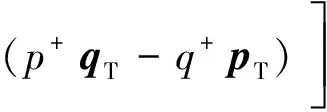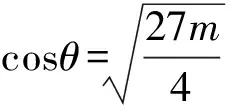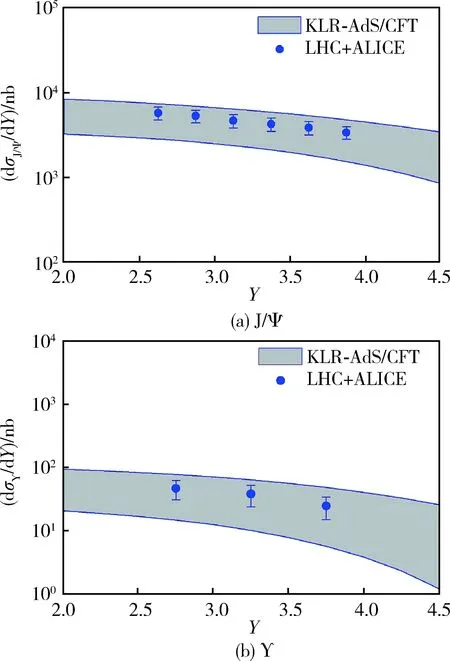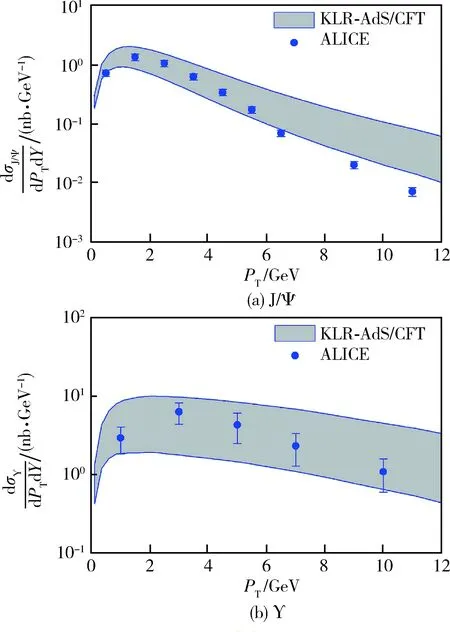高能质子-质子碰撞中的J/ψ和Υ产生
王宏民, 孙献静
(1. 装甲兵工程学院基础部, 北京 100072; 2. 中国科学院高能物理研究所, 北京 100049)
高能质子-质子碰撞中的J/ψ和Υ产生
王宏民1, 孙献静2
(1. 装甲兵工程学院基础部, 北京 100072; 2. 中国科学院高能物理研究所, 北京 100049)
利用色玻璃凝聚理论(Color Glass Condensate, CGC),在假定入射核和靶核分别处于稀-密极限状态下分析了高能质子-质子碰撞中的璨(底)夸克对产生。在此基础上,利用由适用于较小x区域的KLR-AdS/CFT(Kovchegov Lu Rezaeian Anti-de Sitter-space/Conformal Field Theory)色偶极模型获得的偶极关联因子,根据色蒸发模型(Color Evaporation Model, CEM)研究了高能质子-质子碰撞中产生的J/ψ和Υ介子微分截面随快度和横向动量的变化规律。结果表明:理论值与欧洲大强子对撞机(Large Hadron Collider,LHC)实验结果基本一致,但在J/ψ产生截面的大横向动量区域还需要进一步的理论研究。
色蒸发模型; 偶极关联因子; 色玻璃凝聚

在实验方面,目前欧洲大强子对撞机(Large Hadron Cluider,LHC)ALICE合作组给出了质子-质子碰撞中J/ψ(Υ)介子产生截面的实验数据[4]。该实验中质子-质子碰撞的质心能量很高(7 000 GeV),需要涉及较小动量分数(x<10-6)区域的理论计算。由于传统的GBW(Golec-Biernat Wüsthoff)模型[7]、IIM(Iancu Itakura Munier)模型[8]、MV(McLerran-Venugopalan)模型[9]以及Soyez模型[10]都建立在微扰量子色动力学基础上,在极小x区域它们的正确性值得怀疑。为了解释LHC最新实验现象,笔者在计算靶核中的偶极关联因子时采用了适用于较小动量分数的KLR-AdS/CFT(KovchegovLuRezaeianAnti-deSitter-space/ConformalFieldTheory)色偶极模型[11]。
1 理论模型

(1)

Sy(x2,kT)Sy(x2,pT+qT-kT),
(2)


(3)



(4)


(5)


(6)
式中:

(7)
aT=qT-kT,
(8)
p+=p0+p3,
(9)
q+=q0+q3,
(10)

1.2 计算J/ψ(Υ)介子产生截面的色蒸发模型
根据色蒸发模型,J/ψ介子产生的微分截面可表示为[6]

(11)


(12)


1.3KLR-AdS/CFT模型中的偶极关联因子
KLR-AdS/CFT胶子量子态饱和模型建立在=4超杨米尔斯理论基础上,它仅利用3个自由参数就很好地解释了HERA加速器动量分数和四动量都较小时的实验数据。在KLR-AdS/CFT模型中,偶极散射振幅可表示为[14-15]

(13)
相应的饱和标度为

(14)
式中:x为动量分数;rT为胶子的横向位置;
(15)
其中,




(16)
通过拟合HERA实验数据可得到参数λ=20,M0=0.006 16[11]。
KLR-AdS/CFT模型中的偶极关联因子可通过对式(13)进行傅立叶变换得到[16-17],即

(17)
2 结果与讨论

由图1、2可以看出:实验误差在理论不确定区间内,但当横向动量较大时J/ψ介子实验值在理论不确定区间外。这是因为当PT较大时,动量分数x1和x2处在极限区域,这一区域的入射胶子分布函数及偶极关联因子与拟合实验数据存在较大误差[5,11]。

图1 J/ψ(Υ)介子产生截面随快度变化曲线

图2 J/ψ(Υ)介子产生截面随横向动量变化曲线
3 结论
笔者研究了LHC能量下质子-质子碰撞过程中的J/ψ(Υ)介子产生,可得出如下结论:1)色玻璃凝聚理论是解决胶子饱和实验现象的有效方法;2)KLR-AdS/CFT胶子饱和模型适用于碰撞能量较高时的理论计算。
然而,本文研究尚不能解释大横向动量J/ψ介子产生现象,下一步将对此进行重点研究。
[1] DUCLOUE B,LAPPI T,MNTYSAARI H.Forward J/ψ production in proton-nucleus collisions at high energy[J].Phys Rev D,2015,91(11):114005.
[2] MA Y Q,VENUGOPALAN R,ZHANG H F.J/ψ production and suppression in high energy proton-nucleus collisions[J].Phys Rev D,2015,92(7):071901.
[3] FUJII H,WATANABE K.Leptons from heavy-quark semileptonic
decay in pA collisions within the CGC framework[J].Nucl Phys A,2016,951(7):45-49.
[4] ALICE Collaboration.Measurement of quarkonium production at forward rapidity in pp collisions ats1/2=7 TeV[J].Eur Phys J C,2014,74(8):2974-2994.
[5] PUMPLIN J,STUMP D R,HUSTON J,et al.New generation of parton distributions with uncertainties from global QCD analysis[J].JHEP,2002,6(7):012.
[6] WANG H M,HOU Z Y,SUN X J.Cold nuclear matter effects on J/ψ production in d-Au collisions[J].Chin Phys C,2008,32(11):892-896.
[7] GOLEC-BIERNAT K,WÜSTHOFF M.Saturation effects in deep inelastic scattering at low Q2and its implications on diffraction[J].Phys Rev D,1999,59(1):014017.
[8] IANCU E,ITAKURA K,MUNIER S.Saturation and BFKL dynamics in the HERA data at small-x[J].Phys Lett B,2004,590(3/4):199-208.
[9] MCLERRAN L,VENUGOPALAN R.Computing quark and gluon distribution functions for very large nuclei[J].Phys Rev D,1994,49(5):2233-2241.
[10] SOYEZ G.Saturation QCD predictions with heavy quarks at HERA[J].Phys Lett B,2007,655(1/2):32-38.
[11] KOVCHEGOV Y V,LU Z,REZAEIAN A H.Comparing AdS/CFT calculations to HERA F2Data[J].Phys Rev D,2009,80(7):074023.
[12] FUJII H,WATANABE K.Heavy quark pair production in high energy pA collisions:quarkonium[J].Nucl Phys A,2013,915(10):1-23.
[13] FUJII H,GELIS F,VENUGOPALAN R.Quark pair production in high energy pA collisions:general features[J].Nucl Phys A,2006,780(3/4):146-174.
[14] 王宏民,许永晗,孙献静.超高能核-核碰撞中的重子阻止现象[J].装甲兵工程学院学报,2012,26(6):99-102.
[15] WANG H M,HOU Z Y,LIU J F,et al.D-meson production in an AdS/CFT inspired model at the LHeC[J].J Phys G,2011(38):115003.
[16] DUMITRU A,HAYASHIGAKI A,MARIAN J J.The Color Glass Condensate and hadron production in the forward region[J].Nucl Phys A,2006,765(3/4):464-482.
[17] MA Y Q,VENUGOPALAN R.Comprehensive description of J/ψ production in proton-proton collisions at collider energies[J].Phys Rev Lett,2014,113(19):192301.
(责任编辑:尚菲菲)
J/ψ and Υ Generation in High Energy Proton-proton Collisions
WANG Hong-min1, SUN Xian-jing2
(1. Department of Fundamental Courses, Academy of Armored Force Engineering, Beijing 100072, China; 2. Institute of High Energy Physics, Chinese Academy of Science, Beijing 100049, China)
By assuming the projectile and target nuclei in the dilute-dense limit, the charm (bottom) quark pair productions in high energy proton-proton collisions are analyzed in the framework of the Color Glass Condensate (CGC). Then, with the Color Evaporation Model (CEM), the J/ψ and Υ mesons cross section as a function of transverse momentum and rapidity are studied. The dipole correlator is obtained from the KLR-AdS/CFT (Kovchegov Lu Rezaeian Anti-de Sitter-space/Conformal Field Theory) model, which is valid at very small momentum fraction x. It is shown that the theoretical results agree well with almost of all the experimental data form Large Hadron Collider(LHC). But the J/ψ mesons production at large transverse momentum should be further studied.
Color Evaporation Model (CEM); dipole correlator; Color Glass Condensate (CGC)
1672-1497(2017)02-0107-04
2017-01-12
国家自然科学基金资助项目(11305195/A050509)
王宏民(1975-),男,副教授,博士。
O572.24+3
A
10.3969/j.issn.1672-1497.2017.02.022

